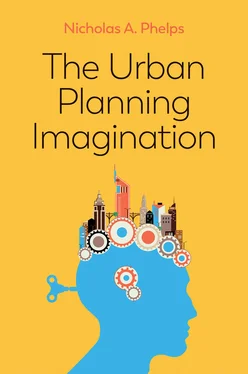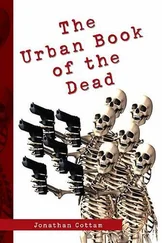Flows: the metabolism of cities
Urban planning has long wrestled with the relationship of the settlement of land to the flows under, over and across it that affect the health of citizens and that are needed to sustain settlement. The need for the healthy metabolism of cities that informed early modern planning drew inspiration from already mature water, waste and metro-system engineering achievements. However, flows arguably take on new individuated meaning in an information-rich age (Castells, 2005) with implications for the balance of citizen, club and state planning actors as they continue to shape our cities.
The supply of water and the removal of waste have been central to ancient and modern urban planning alike. They were the early and universal concerns of modern urban planning as it developed from the 1800s onwards in the global north, as I discuss in the next chapter. Cities such as London and Paris pioneered the introduction of city-wide water-supply and sewerage systems, and these were rapidly exported to overseas colonies as perhaps the ingredients absolutely central to the planning of new and expanded cities.
The same concern with planning for flows in and through the city emerged in connection with the desire to improve the efficiency of movement of goods and people. The first mass public transit system in the world, London’s Metropolitan Railway, opened as early as 1863. Later, in the 1950s and 1960s, American cities were to pioneer planning to increase efficient movement within cities, catering on a massive scale for car use. The European Commission has sought explicitly, with the funding of transport networks, to fashion a Europe of flows (Jensen and Richardson, 2004), though policy and discourse for this continental space of flows continue to rub against discourse, practice and politics at city, regional and national scales (García Mejuto, 2017).
Diasporas and international trade were the two main vectors in the ancient world (Clark, 2013: 5). They re-emerged in a first global economy of the late 1800s to early 1900s and in a second global economy of the 1980s to the present (Jones, 2005). In particular, the urban planning imagination in many cities is being informed by intensified flows of people – superdiverse citizen actors in some cities. Urban planning systems are faced with the bifurcation of these flows of citizen actors into mass domestic and transnational flows of low-skilled, low-wage labour and flows of labour market and consumer elites that form part of a TCC (Sklair, 2001) that I discuss in chapter 7.
China has a long history of internal migration that continues into the present in altogether more massive flows from exporting rural provinces. Migrants arrive as floating workforces without full rights as citizens in the booming cities of the eastern seaboard. An international labour market and offshore manufacturing hinterland have been planned for Singapore since the 1980s. The trade and labour market arrangements agreed under the Indonesia–Malaysia–Singapore Growth Triangle (IMS-GT) significantly underpin the continued growth of an otherwise land- and population-limited city-state economy. Each day, thousands of workers commute into Singapore from Indonesia and Malaysia, while flows of executives and skilled workers go in the other direction to factories in Johor and Riau. The IMS-GT simply exceeds other transnational metropolitan or megalopolitan economies such as Tijuana–San Diego–Los Angeles in terms of the planning involved.
A diverse, internationally mobile elite have effects on urban planning systems and cultures in world cities. They include both those who speculate in land and property and well-paid workers deployed by multinational enterprises. These flows can blinker the urban planning imagination. Local urban planning systems have licensed processes of gentrification, resulting in the segregation of elite global populations into favoured quarters within world cities (Butler and Lees, 2006). Away from cities such as London and New York, the same condoning of inequality in urban planning systems is registered in the permitting of gated residential communities for global elites in Johannesburg or Guadalajara that promise the ‘splintering’ of urban space (Graham and Marvin, 2000). The impacts can be triply specific in that they focus local urban planning attentions on the redevelopment of particular city spaces, often in the form of mixed-use mega-projects, in many instances with a preference for iconic architecture. Mega-projects have been controversial for their loading of financial risk upon the public sector (Flyvbjerg and Sunstein, 2016; Tarazona Vento, 2017) and the way in which ‘special-purpose delivery vehicles’ have been used to circumvent local planning procedures and reposition cities for moneyed outsiders (Swyngedouw et al, 2002: 545–6). Many world cities are currently being remade not in the image of relatively inclusive paternalistic states or large numbers of citizens but in a troubling state–club fusion catering to the wealthy.
A heightened sense of inter-urban competition is signalled in these and other flows and has prompted plans which have become more indicative than previously; sharp lines and clear land-use allocations replaced with fuzzy boundaries and sweeps of likely development. The visual imagery now implies dynamism often beyond the jurisdiction of the plan itself. This indicative turn is associated with changes in the temporality of plans and, of course, the abandonment of any sense of their binding nature. Something of this is seen in the key visuals associated with recent metropolitan plans and their revisions (see, for example, Helsinki 2050, Canberra 2030, New South Wales 2050). It is named in what Allmendinger and Haughton (2009) refer to as the ‘soft planning spaces’ that have emerged at the subnational scale in the UK, where those spaces involve deliberate attempts to introduce new and innovative cross-sectoral and inter-territorial ways of thinking in urban planning.
Virtuality and synchronicity
While similar or identical tendencies in societal constructs are commonly taken as evidence of a world society (Meyer et al., 1997), these same tendencies have been apparent historically. Thus, ‘we need to ask if … similarities … are the result of common but autarkic human responses to the structural processes of urbanization … and how far they are the effect of “connectivity” – the transfer of cultural, commercial and other ideas’ (Clark, 2013: 4).
There is historic evidence of synchronous but independent developments in urban systems in different parts of the world (Clark, 2013; Kostof, 1991). The grid is one geometric organizing principle used in the planning of cities. ‘Far more than a representation or signifier, the grid is a world-making device that literally brings new worlds into being’ (Rose-Redwood and Bigon, 2018: 3, original emphasis), as seen in the case of Melbourne in chapter 7. While the form may be universal, variations are apparent. The rectilinear grids of the ancient Roman and Chinese empires were physically similar but produced from contrasting creative mentalities (Laurence, 2013). The grid provides evidence of synchronicity but does not submit to simple stories of origin or imposition (Rose-Redwood and Bigon, 2018).
Today, the similarities that we notice between cities are more likely to be a product of the virtual connections between citizens, clubs or states in webs of exchange of images, ideas, practices and methods facilitated by information and communication technologies (ICTs). Built-environment professionals – architects, realtors, planners – have always borrowed but are now able to scan the world far more rapidly than in the past. Will planning be little more than ‘cut and paste’ or ‘photoshop planning’ (Rapoport, 2015)? Global perceptions of a city such as Dubai – one of the ‘born global’ cities and planning systems discussed in chapter 7– are derived from very particular representations of it (Elsheshtawy, 2009). Indeed, the prominence of Dubai in popular perceptions and rankings has been consciously planned through the construction and projection of the symbolic power of high-rise architecture (Acuto, 2010).
Читать дальше












![Nicholas Timmins - The Five Giants [New Edition] - A Biography of the Welfare State](/books/701739/nicholas-timmins-the-five-giants-new-edition-a-thumb.webp)